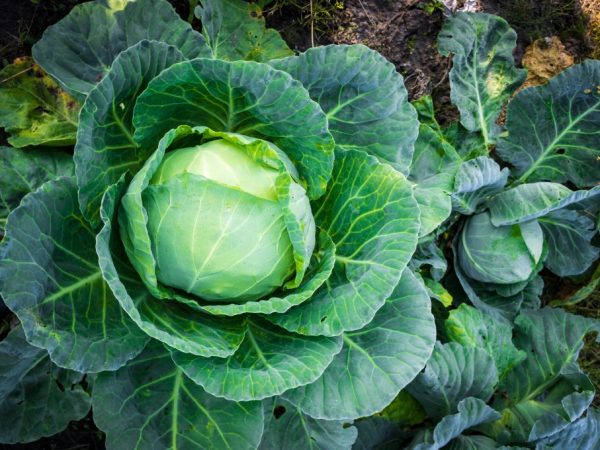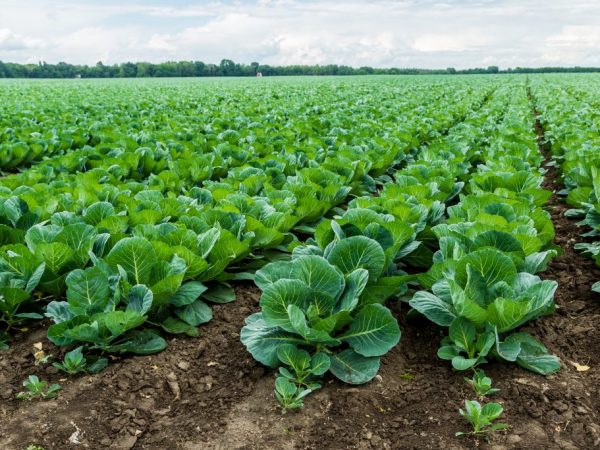Description of cabbage variety Zimovka
Among the huge variety of varieties, Zimovka 1474 cabbage stands out due to its qualities. It was developed as a versatile variety suitable for growing in any region.

Description of cabbage variety Zimovka
Variety characteristic
White cabbage Zimovka 1474 belongs to the mature varieties.
From the moment the first shoots appear and until the technical ripeness of the heads of cabbage, it takes about 150-160 days. Sometimes, under favorable conditions, cabbage ripens a week earlier.
The variety is very yielding: from 1 sq. m receive 5-7 kg. Even with minimal care, cabbage grows well and fully develops. That is why it is grown on an industrial scale in the fields.
Description of the head of cabbage
Heads of cabbage in comparison with other varieties are very large, from 3 to 5 kg each. Subject to all the requirements of agricultural technology, a small stump is formed. It is sweet, crunchy and edible. If the cabbage was treated with pesticides, it is better not to eat the core. All harmful substances accumulate in it.
The description of the Zimovka cabbage variety fully corresponds to its unusual name. Heads of cabbage are well stored throughout the winter without losing their beneficial properties and nutritional value. It is recommended to store the vegetable in dry basements with good ventilation.
White cabbage Wintering 1474, transportation over long distances is not terrible. Leaves in a head of cabbage are strong, fit tightly to each other. It is better to transport the vegetable in mesh bags of 15-20 kg each.
Application of the vegetable
Wintering can be used to prepare:
- fresh salads;
- first courses (borscht, cabbage soup);
- side dishes.
It is also fermented in special barrels or simply in small containers. To do this, finely chop the head of cabbage, add grated carrots, cranberries, apples or herbs to taste. A brine is prepared from salt, sugar and water, which is poured into chopped cabbage. For aroma add allspice and black pepper, cloves, bay leaves and nutmeg.
In fermented form, the vegetable contains a huge amount of vitamin C, which is formed by natural fermentation. This salad is not only tasty, but also healthy.
Care

Plants need sunlight
The plant is easy to care for and can grow in almost any climate. You can plant late varieties in a seedless way. In case of frost, the seedlings are covered with a film.
It is important to choose a good spot for your cabbage patch. Culture is demanding of the sun. In the shade, the sprouts quickly stretch out and bloom. They do not form a head of cabbage, and if this happens, it is small and loose.
You need to water the plant 1-2 times a week, depending on weather conditions. With an excess of moisture in a rainy summer, heads of cabbage can crack and rot. Such copies are not subject to storage. Even at the root, they quickly deteriorate.
For normal growth and development, feeding is important. They feed the culture like this:
- Fertilizers are applied for the first time before planting seeds in the ground. Wood ash, rotted mullein and sawdust are added to the holes.
- The second time seedlings are fed at the stage of formation of 3 leaves.For this, bird droppings are soaked in a container of water for 2 weeks. When fermentation stops, the solution is diluted with water in a ratio of 1:10. Each plant is gently watered under the root. Previously, the beds are watered abundantly with plain water.
- The third stage occurs at the stage of surebets formation. 30 g of superphosphate is dissolved in 10 liters of water and this is poured over each bush under the root.
Pests and diseases
Unlike modern hybrids, Zimovka cabbage most often gets sick:
- black leg;
- downy mildew;
- various forms of bacteriosis;
- keel.
To combat these diseases, it is necessary to treat plants with Fitosporin before setting the forks.
This cabbage variety can be affected by the cruciferous flea beetle. This small black insect feeds on plant leaves. Small holes remain on the heads of cabbage, which worsens the presentation of the crop. They fight the pest by dusting the plants with a mixture of wood ash and red pepper powder.
If the cabbage grows in a dark or overly damp area, it is damaged by slugs and grape snails. Insects are scared away by wood ash scattered over the garden bed or removed by hand. You can also lay out lures in the form of cut cucumbers or zucchini around the perimeter of the site. Slugs and snails will crawl in there.
White butterflies or cabbage butterflies also cause irreparable damage to the crop. They lay their eggs in the leaves of a forming fork. The hatched caterpillars quickly eat the head of cabbage from the inside. To scare away the butterfly, the bushes are sprayed with a solution of laundry soap. For these purposes, you can also use pesticides.
Conclusion
According to the description, cabbage Zimovka 1474 is productive and has excellent keeping quality of cabbage heads. The vegetable can be stored in the basement for 7-8 months. It is advisable to stack the heads of cabbage on wooden pallets with the cut up.
Do not store cabbage in warm or poorly ventilated areas. This can lead to rotting of the top leaves of the fork and cut.


